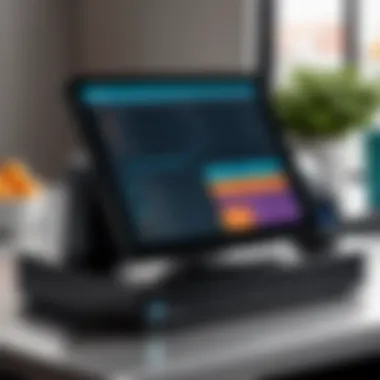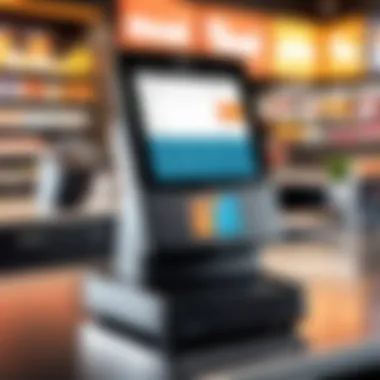Understanding Revel Systems POS Pricing in Detail


Intro
Revel Systems offers a comprehensive point-of-sale (POS) solution suitable for various business types. For potential users, understanding the pricing structure is vital for informed decision-making. The costs associated with Revel Systems depend on several factors including features, business size, and specific operational needs. This article aims to demystify these pricing tiers and their implications for business strategies.
Key Features
Overview of Features
Revel Systems POS provides a robust set of features tailored to enhance business operations. Key functionalities include inventory management, employee scheduling, customer relationship management, and detailed reporting tools. These features work in tandem to streamline processes and provide actionable insights.
Unique Selling Propositions
One of the most notable selling points of Revel Systems is its flexibility. Businesses can customize their POS systems according to their unique requirements. This adaptability is crucial for companies looking to scale their operations. Additionally, Revel Systems emphasizes user-friendly interfaces, ensuring that your team can learn and adapt to the system quickly. The capacity to integrate with third-party applications also sets Revel apart in the marketplace.
"Understanding the features allows businesses to align their goals with the capabilities of the POS system, maximizing investment."
Pricing Models
Different Pricing Tiers
Revel Systems' pricing comprises several tiers, which can fluctuate based on business needs and scale. Generally, businesses can expect to pay for software licenses, hardware components, and ongoing support. The approximate monthly cost for the software can start from $99, while robust features and necessary hardware can increase this figure.
ROI and Cost-Benefit Analysis
When assessing whether Revel Systems is a viable choice, it is prudent to conduct a return on investment (ROI) analysis. Consider the potential increases in efficiency and sales due to improved operations. For example, businesses often find that better inventory management leads to reduced waste and enhanced customer satisfaction. Calculating potential savings and revenue against the total cost provides a clearer picture of the overall value.
Understanding these financial aspects prepares businesses to make sound decisions about incorporating Revel Systems into their operations.
Overview of Revel Systems
Understanding Revel Systems as a point-of-sale (POS) solution is critical for businesses looking to enhance their operational efficiency and customer service. This section presents the foundation of what Revel Systems offers, allowing readers to grasp the entire pricing analysis context better. By recognizing the unique aspects of this POS system, such as its adaptable features and user-friendly interface, decision-makers can make informed choices relevant to their needs.
Foreword to Revel Systems
Revel Systems is a cloud-based POS system tailored for restaurants, retail, and other service-oriented businesses. This platform integrates various functions like inventory management, customer relationship management, and employee scheduling in one interface. Launched in 2010, Revel has since gained a reputation for being a flexible solution that supports multiple locations and devices.
Businesses using Revel Systems benefit from streamlined operations due to its comprehensive suite of tools. The POS system allows businesses to maintain inventory levels effectively, manage customer data, and analyze sales in real time. Knowledge of these features is essential for those considering adopting this technology.
Key Features of Revel Systems
Revel Systems is distinguished by a range of features designed to improve transaction accuracy and speed. Key elements include:
- User-Friendly Interface: The intuitive layout helps staff quickly learn the system, reducing training time.
- Real-Time Reporting: Businesses can access up-to-date sales and inventory data, aiding informed decision-making.
- Customer Profiles: The ability to create and maintain detailed customer profiles enhances personalized service.
- Customizable Menus: Especially crucial for restaurants, this feature allows for easy updates and unique offerings.
- Mobile Support: This feature permits transactions from various devices, providing flexibility in point-of-sale locations.
Understanding these features aids businesses in assessing whether Revel Systems meets their specific operational requirements, efficiency goals, and customer service standards.
Revel Systems POS Pricing Model
The Revel Systems POS pricing model is vital for businesses assessing their point-of-sale needs. Understanding the pricing model enables business owners to allocate budgets effectively and evaluate if the offered features match their operational requirements. Different pricing tiers and structures can impact the overall cost, making it essential to dissect these components thoroughly. Selecting the right pricing model can lead to enhanced efficiency and better customer experiences.
Understanding the Pricing Structure
Understanding the pricing structure is pivotal for businesses. Revel Systems utilizes a tiered pricing approach, which means costs can vary based on selected features and services. Each tier typically includes a range of functionalities that cater to different business sizes and needs. For instance, smaller businesses might opt for basic plans that cover standard POS services, while larger enterprises may require more complex systems with additional integrations and support.
Crucially, it's important for potential users to analyze which features they genuinely need and how those features reflect on the overall pricing. Doing so aids in preventing the pitfalls of overspending on unutilized capabilities.


Monthly Subscription Costs
Monthly subscription costs are a significant aspect of the Revel Systems POS pricing model. Businesses should anticipate monthly fees; these costs vary based on the subscription tier chosen. On average, the monthly rates can be more favorable over time compared to one-time payments.
Here are some key factors related to monthly costs:
- The base subscription often covers essential functionalities involved in retail or restaurant management.
- Each tier may incorporate various modules, such as inventory management and customer relationship tools, influencing the pricing.
Vigilant consideration of whether a plan meets current and anticipated future needs is wise. Adjustments or expansions in services might necessitate a reevaluation of the subscription plan.
Initial Setup Fees
Initial setup fees can represent a considerable investment when adopting Revel Systems. This fee structure is crucial, as it represents the costs involved in configuring the system for use, which includes hardware and software setup, as well as installation.
- Initial fees typically cover the cost of hardware such as terminals, tablets, and card readers.
- Software configuration may require time and expertise, often reflected in these setup fees.
Potential customers should inquire about these fees upfront to avoid unexpected financial burdens during implementation. Understanding these costs will enable businesses to assess whether they align with their budgets and get a clearer picture of the overall investment.
Additional Service Fees
Additional service fees are another component in evaluating physically engaging with Revel Systems. While base subscriptions cover primary functionalities, further costs may arise from added features or support services.
Consider these examples of additional fees:
- Advanced reporting tools: These are often available at an extra cost and can provide deeper insights into sales and customer trends.
- Payment processor fees: If specific payment methods are required, these may incur additional charges.
- Customer support packages: Enhanced support options can also come with their own pricing.
Being informed about potential extra fees will equip businesses with the necessary knowledge to manage costs effectively and maintain financial control.
Comparison of Pricing Plans
When businesses consider the integration of a point-of-sale system, understanding the various pricing plans is essential. This section will examine Revel Systems' pricing plans, digging into their specific features, benefits, and other considerations. Business owners must evaluate not just the costs but also what they get in return. A smart comparison helps to determine which plan aligns with specific needs and how it can fit into the overall budget.
Standard Pricing Plan
The Standard Pricing Plan is designed for typical small to mid-sized businesses. It includes core functionalities necessary for daily operations. This plan is less complex, making it more accessible for businesses that don't require extensive customization. Features often include operational management tools, basic reporting capabilities, and standard customer support.
Benefits of the Standard Pricing Plan:
- Affordability: This plan allows businesses to manage costs without sacrificing quality.
- Ease of use: The straightforward features support quicker training and implementation.
- Sufficient for many small functions: Many businesses find the standard features meet their needs.
However, it is important to understand that while it offers solid tools, heavier operations may require upgrades to a more expansive plan in the future.
Enterprise Pricing Plan
In contrast, the Enterprise Pricing Plan caters to larger organizations with complex operational needs. This plan includes all capabilities of the Standard Plan but adds advanced features. Businesses get enhanced reporting, integration options, and scalable solutions designed to support growing needs. Customization is a significant element, as enterprises often need tailored options to fit their unique workflows.
Details of the Enterprise Pricing Plan:
- Comprehensive Reporting: Provides analytics that help management make informed decisions.
- Dedicated Support Teams: Enhanced customer service is pivotal for larger installations.
- Greater customization: Organizations can tailor the system to suit complex workflows.
With its vast array of features, this plan is suitable for businesses expecting high volumes of transactions or those with high customization needs. The trade-off is the higher cost associated with this expanded capability.
Custom Pricing Solutions
Some businesses may not find their requirements fully met by the Standard or Enterprise plans. Revel Systems recognizes this need and offers Custom Pricing Solutions. This enables businesses to tailor the POS system precisely to their needs. The pricing is flexible and reflects the specific features needed, combining various elements from both plans.
Factors of Custom Pricing Solutions include:


- Tailored Features: Businesses can select only the functionalities they need.
- Scalable Development: As business needs change, so can the system capabilities.
- Potential Cost Optimization: Custom solutions can occasionally offer savings, as unnecessary features are avoided.
This option is particularly useful for niche markets or rapidly growing businesses that may not fit traditional pricing models. Overall, the choice of pricing plan should align with the specific operational strategies and future growth projections of the business.
Evaluating Cost-Effectiveness
Evaluating cost-effectiveness is a crucial part of selecting any point-of-sale (POS) system. For businesses considering Revel Systems, understanding its financial implications allows for a well-informed decision. It goes beyond just examining monthly fees or upfront costs. By focusing on the entire value proposition, one can align financial commitments with operational needs. This section unveils several facets of cost-effectiveness related to Revel Systems, which are essential for savvy business owners and decision-makers.
Hidden Costs to Consider
When evaluating the overall cost of owning a POS system, one must consider various hidden costs. These expenses can often catch businesses off-guard, leading to inflated operational budgets. Here are some hidden costs related to Revel Systems:
- Transaction Fees: Beyond the subscription costs, transaction fees per sale can accumulate significantly. Merchants must consider these as part of the total cost of ownership.
- Hardware Expenses: Initial setup may require purchasing specialized hardware like tablets, cash drawers, and receipt printers. This can escalate costs significantly, particularly if replacement or upgrades are needed.
- Software Upgrades: Some plans may come with limited updates. If your business requires premium features or customizations, additional fees may apply for upgrading the software.
- Training Expenses: While some training is typically included, ongoing training for staff or new hires may incur extra costs as well. Businesses need to evaluate how much training will be necessary to maintain operational efficiency.
"Ignoring hidden costs can lead to budget overruns that hamper your business's growth potential."
Being aware of these hidden expenses can help businesses adjust their budgeting and operational tactics accordingly.
Value for Money
Assessing value for money is central to evaluating the overall effectiveness of the Revel Systems POS. Beyond the monetary aspect, this concept encapsulates cost in relation to the benefits received. Key considerations in this area include:
- Features vs. Cost: Does the functionality provided by Revel justify its costs? The analysis must reflect on whether the features available sufficiently meet business needs. For instance, advanced reporting tools and inventory management capabilities can enhance operational efficiency, possibly offsetting higher costs.
- Scalability: As a business grows, its requirements tend to evolve. Evaluating whether Revel's system can adapt to these changes without incurring prohibitive additional costs is essential for understanding its long-term value.
- ROI Metrics: Measuring return on investment is essential. Businesses should project how the system can boost sales, improve customer satisfaction, or streamline operation. A robust ROI can help validate the investment in Revel.
In summary, evaluating cost-effectiveness is not just about surface costs. It requires a comprehensive analysis of all related expenses and the value being returned to the business. By looking at the big picture, decision-makers can make more informed choices about investing in Revel Systems.
Industry Comparisons
Understanding the landscape of point-of-sale (POS) systems is crucial for businesses looking to make informed purchasing decisions. In this section, we will explicitly compare Revel Systems POS with its notable competitors, Square POS and ShopKeep. This comparison not only highlights the strengths and weaknesses of these systems but also assists decision-makers in aligning their operational needs with the right technology.
Revel vs. Square POS
When evaluating Revel Systems against Square POS, it is essential to consider several aspects that make each system unique. Revel Systems is known for its comprehensive feature set tailored for larger businesses with complex needs. Its integration capabilities, advanced reporting, and multifunctional platform attract a diverse range of industries, including restaurants and retail. Here are some main points of comparison:
- Feature Set: Revel offers a more robust inventory management system compared to Square. Users can customize their menus, track ingredient usage, and manage suppliers effectively.
- Pricing: Revel's pricing is generally higher than Square's, reflecting its broader capabilities. Square operates on a pay-as-you-go model, making it more appealing for low-volume businesses or startups.
- Hardware Compatibility: Square provides a simpler setup with its proprietary hardware, while Revel enables the use of various third-party devices, catering better to businesses that require specific tool integrations.
- User Experience: Square is often praised for its user-friendly interface that appeals to non-tech-savvy users. Revel's system may have a steeper learning curve due to its extensive features.
Overall, Revel Systems might be better suited for businesses seeking a powerful POS solution with extensive capabilities, while Square POS excels in simplicity and cost-effective usage for smaller enterprises.
Revel vs. ShopKeep
In a direct comparison with ShopKeep, Revel Systems again showcases its strengths and competitive edge. Both systems serve the retail and hospitality sectors but differ in operations and pricing structures. Here are key considerations:
- Pricing Structure: Revel has more complex pricing than ShopKeep. ShopKeep offers straightforward subscription fees, which many small business owners find appealing. Revel's diverse offerings cater to mid-sized and large businesses but may be burdensome for smaller establishments.
- Customization: Revel excels in customization options for its users, allowing for tailored reporting and functionality. ShopKeep, while user-friendly, may not offer the same level of adaptability, which can limit operational flexibility.
- Support Services: Both systems provide customer support, but Revel's offering may include higher-level services suitable for complex business environments. ShopKeep is often recognized for its superior customer service experience in smaller business contexts.
- Integration Options: Revel boasts numerous integrations with various e-commerce platforms, while ShopKeep tends to be more restrictive. This flexibility in Revel can be particularly beneficial for businesses looking to expand their digital presence.
"Investing in the right POS system can significantly impact operational efficiency and overall profitability."
By comparing Revel Systems with its competitors, businesses can gain valuable insights into the strengths and limitations of each system. Such knowledge is essential for making decisions that align with specific needs and future growth plans.
Customer Support and Training
Customer support and training are critical components for users of Revel Systems POS. Businesses rely on effective support systems to resolve issues swiftly and maintain operational efficiency. Training is equally important as it enhances user proficiency, ensuring that staff can utilize the system to its fullest potential.
One of the indispensable features of Revel Systems is its customer support options. These offerings allow businesses to access help when needed. The right support can lead to reduced downtime and help companies navigate any complications with their POS systems, promoting uninterrupted service. Moreover, training programs can boost user confidence, thus maximizing the functionalities of the system from day one.
Support Pricing Plans


Revel Systems provides various support pricing plans designed to meet varying business needs. The plans can include technical support via phone or online chat, as well as access to a knowledge base. Understanding these plans is essential, as they can impact the overall costs and effectiveness of the support service.
- Standard Support: This usually offers basic coverage during business hours, which might suit small businesses.
- Premium Support: This level often includes 24/7 availability and faster response times. Larger businesses or those operating in critical hours may find this plan beneficial.
- Customized Support Plans: For organizations with unique needs, Revel Systems also offers tailored support solutions. Businesses can negotiate coverage that fits their operation hours and response time expectations.
Training Costs
Providing adequate training for staff on Revel Systems is another area where businesses need to consider expenses. Training costs vary based on the level of instruction required. Some options include classroom training, online tutorials, and one-on-one sessions.
- Initial Training: Many companies opt for a dedicated training session when first implementing Revel Systems. This cost varies based on the number of employees trained and the complexity of the training.
- Ongoing Training: As features update or when new staff is hired, ongoing training may be necessary. Companies should plan for these costs to ensure they maintain a knowledgeable workforce.
Investing in proper training can significantly enhance team efficiency and satisfaction with the platform.
Investing in robust customer support and training can be seen as a proactive approach. It sets a foundation for effective system usage and drives productivity. This makes these expenses a pivotal aspect of a business's financial planning regarding their POS system.
User Testimonials and Experiences
User testimonials are invaluable in understanding the performance of Revel Systems POS. These experiences provide insights that extend beyond basic features and pricing. When potential users delve into testimonials, they tap into real-world applications of the system. This section emphasizes the importance of user experiences, focusing on both positive feedback and challenges faced by current users.
Positive Feedback
Numerous users commend Revel Systems for its robust functionality and user-friendly interface. Many small to mid-sized businesses report that the platform seamlessly integrates with their operational flow. Common praise includes its intuitive design, which reduces the learning curve for staff.
Additionally, Revel's inventory management capabilities attract positive remarks. Owners appreciate the real-time tracking of stock levels. This feature is critical for inventory management and allows for timely restocking, preventing unfavorable stock-outs. Also, the remote access function is often highlighted. Business managers can monitor sales and inventory from anywhere, providing flexibility and convenience.
Here are some of the key aspects that users often appreciate about Revel Systems:
- Customization Options: Businesses can tailor the system to meet their exact needs, which enhances operational efficiency.
- Excellent Customer Support: Many users report positive experiences with customer support. Quick response times and knowledgeable representatives are frequently mentioned.
- Detailed Reporting Features: The comprehensive reporting capabilities help owners make data-driven decisions easily.
- Integration with Other Softwares: Many reviews note smooth integration with accounting and e-commerce platforms, facilitating holistic business management.
"Revel Systems changed the way we operate our cafe. It is easy to use, and my employees adapted quickly. I love how I can track everything from my phone." - A satisfied cafe owner
Challenges Faced
Despite the positive experiences, users also highlight challenges that prospective clients should consider. Some users encounter obstacles during the initial setup phase. The complexity of integrating existing hardware can be daunting, especially for those without prior technical experience.
Furthermore, while Revel's features are extensive, some users find that certain functions could be improved. For instance, advanced reporting features may require additional training to fully utilize. Users have mentioned that they wished for more straightforward reporting options.
It is also essential to note that costs can escalate. While the pricing structure seems reasonable, additional functionalities and services may result in higher bills than initially expected. Clients should carefully evaluate their needs and inquire about all potential costs before making a commitment.
Some common challenges reported include:
- Initial Setup Complexity: Integrating with existing systems can take time and effort.
- Learning Curve for Advanced Features: Users may require extra training to effectively use certain functions.
- Potential for Increased Costs: Additional features and services can increase overall expenses.
Epilogue
In any deep evaluation of a point-of-sale system like Revel Systems, the conclusion holds significant value. It serves as the final synthesis of the various elements discussed throughout the article. The key insights from Revel Systems’ pricing, features, and customer experiences guide potential users in making informed decisions.
The conclusion acts as a summary that highlights the financial implications of choosing Revel Systems over other options. It showcases the value that the system provides versus its costs. Additionally, it emphasizes the practical aspects of implementing and utilizing the POS system in a real business environment. Readers must consider how these elements interconnect and influence their overall purchasing decision.
Summary of Key Points
The pricing structure of Revel Systems consists of several layers, each with unique benefits and costs, including:
- Monthly subscription fees that vary based on the chosen plan, tailored to different business needs.
- Initial setup fees which often reflect the complexity of deployment and the scale of business operations.
- Additional service fees that may arise from optional features or support plans.
- The importance of understanding hidden costs that can emerge after switching to the system.
These aspects are crucial as they affect not only the immediate expenses but also the long-term financial strategy of any business that adopts this technology.
Final Thoughts on Revel Systems POS Pricing
As organizations contemplate investing in technology like Revel Systems, it is essential to weigh the pricing against the provided functionalities. Revel Systems offers robust functionalities that can justify its pricing model under the right circumstances. However, potential users should conduct a meticulous analysis of their unique requirements, possible future growth, and potential return on investment.
- Revel Systems is designed to cater to various business models; therefore, understanding its adaptability is key.
- Pricing may appear high, but the comprehensive features and customer support can offset these costs over time.
- Assessing competitor offerings can provide a better sense of market value.
By taking a methodical approach to understanding Revel Systems pricing, decision-makers can ensure they are making a choice that aligns with their business goals and operational needs.













